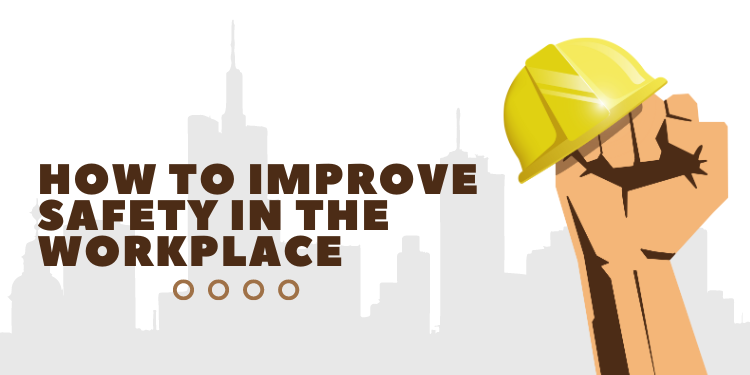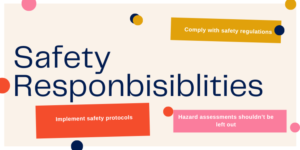Investing in workplace safety is a strategic decision that benefits both employees and the organization.
With evolving regulations and new challenges, it’s essential to continually assess and improve workplace safety measures to ensure the well-being of employees as this is crucial for maintaining a productive and positive work environment.
This article will provide comprehensive strategies and practices that can significantly improve workplace safety, leading to a healthier, and more productive work environment.
Let’s start with the benefit of a safe work environment for the worker and the employer.
Benefits of a Safe Workplace
For Employers: A safe workplace minimizes medical expenses related to accidents and illnesses, lowers absenteeism and turnover, raises output and productivity, and improves employee morale.
According to the Occupational Safety and Health Administration (OSHA), implementing a workplace safety plan can significantly lower medical expenses associated with illness and injuries by 20% to 40%.
For Employees: Injuries sustained at work can lead to a variety of negative outcomes, including pain and suffering, medical expenses not covered by insurance, and, in the worst-case scenario, death. In light of these, keeping safe at work fosters mental health, and keeps workers healthy enough to perform their tasks and contribute to the workplace growth.
12 Ways to Improve Safety in the Workplace
As we already know, a safe workplace reduces the likelihood of accidents, minimizes downtime, and promotes a positive work culture. Moreover, it helps retain skilled employees, reduces healthcare costs, and enhances the company’s reputation.
Here are the 12 ways to effectively improve safety in the workplace:
1: Conduct Regular Risk Assessment
First, it’s important to conduct regular risk assessments to identify potential hazards. By evaluating these risks, you can identify potential hazards and implement measures to control them, significantly reducing the chances of accidents.
2: Develop and Enforce Safety Policy
Developing and enforcing safety policies is also important. These policies should be clear, written, and regularly updated to comply with the latest safety standards and regulations. Ensuring these policies are consistently enforced across the organization is essential.
3: Promote Safety Culture
Promoting a safety culture within the workplace can make a big difference. Management should demonstrate a commitment to safety, and employees should be encouraged to participate in safety programs and provide feedback. Recognizing and rewarding safe behavior can help reinforce this culture.
4: Use Personal Protective Equipment Appropriately
Using personal protective equipment (PPE) is essential for many tasks. It’s important to identify the necessary PPE, provide it to employees, and ensure they know how to use, maintain, and store it correctly.
5: Maintain a Clean Workplace
In many workplaces, particularly in the healthcare and hospitality sectors, cleanliness is essential. In addition to protecting employees, patients, and clients, a clean workplace is also important for public hygiene. Make sure staff members clear up spills right away and maintain clutter-free flooring. Boxes, trolleys, and other items that could cause trips and falls should not be in the walkways.
6: Routine Maintenance of Equipment
Regular maintenance of equipment and facilities is important to prevent accidents. This includes performing routine maintenance, conducting inspections, and promptly repairing any faulty equipment or infrastructure.
7: Provide Ergonomic Tools and Equipment
Ergonomic solutions can help reduce physical strain and injuries. This involves designing workstations to promote good posture, providing ergonomic tools and equipment, and implementing job rotation to minimize repetitive strain injuries.
8: Encourage Open Communications
Encouraging open communication and reporting is key to identifying and addressing safety concerns. Establishing a clear and anonymous reporting system, fostering an environment where employees feel comfortable discussing safety issues, and thoroughly investigating incidents to prevent recurrence are all important steps.
9: Monitor and Review Safety Performance
Monitoring and reviewing safety performance helps to identify areas for improvement. Tracking safety metrics, conducting regular reviews, and using these findings to improve safety practices continuously are essential for maintaining a safe work environment.
10: Update Policies and Procedures
New practices, guidelines, and tools could be regularly released, depending on the industry. Policies and procedures must be updated appropriately. In addition to receiving extra training as necessary, all workers should be informed of the updated policies and procedures.
11: Provide Continuous Safety Training
Providing safety training for all employees is another vital component. This includes comprehensive training for new employees and ongoing refresher courses for existing staff. Training should also cover emergency procedures, such as fire drills and first aid.
12: Partner with Occupational Professionals
Collaboration with occupational professionals enables you to curate safety standards to the specific needs of your organization. These individuals can also offer advice on preventive measures, ergonomic changes, and recovery programs for employees who have been injured.
Plus they are up to date on the latest safety standards and can provide valuable insight into workplace safety measures.
Overall, improving workplace safety is an ongoing process that requires commitment from all levels of an organization. By prioritizing best practices, and continuous training, organizations can significantly reduce the risk of accidents and create a more secure and productive environment for their employees.
Check out these trainings to learn how the Quoda Safety Consults can help keep your workplace safer.
To round up, let’s look at some frequently asked questions and their respective answers on how to improve safety in the workplace.
FAQs
- How can we ensure continuous improvement in workplace safety?
Continuous improvement can be ensured by regularly reviewing and updating safety procedures, conducting periodic safety audits, analyzing incident reports to identify trends, soliciting employee feedback, and implementing corrective actions promptly.
- How should we handle workplace emergencies to ensure safety?
Handling emergencies involves having a well-documented emergency response plan, conducting regular emergency drills, ensuring all employees are trained on emergency procedures, and having readily accessible emergency equipment and supplies.
- How can we measure the effectiveness of our workplace safety program?
Effectiveness can be measured by tracking key performance indicators (KPIs) such as the number of incidents, near-misses, and lost workdays due to injuries, conducting employee safety surveys, and regularly reviewing safety program outcomes against objectives.
- How can we encourage employees to adhere to safety protocols?
Encouraging adherence to safety protocols can be achieved by creating a strong safety culture, recognizing and rewarding safe behavior, involving employees in safety planning, providing clear and accessible safety guidelines, and leading by example from management.
- What steps should be taken after a workplace accident occurs?
After an accident, ensure immediate medical attention if needed, secure the area to prevent further incidents, conduct a thorough investigation to determine the cause, document the findings, and implement corrective actions to prevent recurrence. Additionally, review and update safety procedures as necessary.
- How can we identify potential hazards in the workplace?
Potential hazards can be identified through regular safety audits, employee feedback, hazard reporting systems, and reviewing incident and near-miss reports. Involving employees in the hazard identification process is also crucial as they are often the first to notice potential risks.




